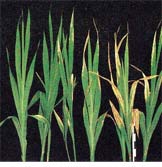 |
>
>
>
|
|
Biomonitoring - monitoring and assessing the effects of air pollutants
Sensitive organisms, e.g. selected and screened plant species, can be used to assess and demonstrate the effects of air pollutants directly on the spot. Therefore, Biomonitoring may be considered one of the most important tools in effect-related environmental monitoring.
Compared to technical measurements, which generally detect single pollutant species with high accuracy and high resolution in time, biomonitoring methods can integrate over all environmental factors, which act upon an organism, and over longer periods of time (e.g. weeks or months):
Not a single pollutant compound, but the combination of all acting pollutants including environmental factors like, e.g. the climate, are determining for potential effects on organisms.
Biomonitoring methods can provide information on pollutant effects in a quantitative way.
|
 |

Injured leaf tips of Gladiolus indicate the effects of fluoride air pollution. The length of the necrotic (=dead) leaf tip is proportional to the pollution load. (VDI Guideline 3957/14). |
|